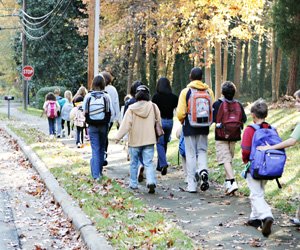

Study reveals more K-8 children are walking to school

New research from the National Center for Safe Routes to School, the clearinghouse for the federal Safe Routes to School program, which is housed at HSRC, shows that more K-8 students are walking to and from school.
According to the parent survey data collected by nearly 4,700 U.S. schools from 2007 to 2012, the percentage of K-8 children who walked to school in the morning increased from 12.4 percent to 15.7 percent. Similarly, the percentage of K-8 children who walked from school in the afternoon increased from 15.8 percent to 19.7 percent.
"We have heard anecdotally that more families are choosing active transportation for everyday trips, and this first-ever large dataset provides evidence that this is indeed the case for the trip to and from school," said Lauren Marchetti, director of the National Center. "This encouraging news illustrates the importance of continuing to invest in building safer infrastructure, promoting safety awareness and continuing programs like Safe Routes to School."
Another significant finding of this research was that the percentage of parents who reported that their child's school supported walking and bicycling for the school commute rose from 24.9 percent to 33 percent."School support for walking and biking is an important element in parents' decisions to allow or to encourage their children to make this transportation choice," Marchetti continued. "And, as nearly 15,000 schools have benefited from Safe Routes to School funding across the country, this is an exciting finding. Together, schools, families and communities can help integrate physical activity into daily life."
The full report, Trends in Walking and Bicycling to School from 2007 to 2012, analyzes parent survey data collected by nearly 4,700 schools located in all states and Washington, D.C., from 2007 through 2012. The surveys represent more than 525,000 K-8 school children across the country. Parent surveys are not considered representative of all households, instead they give insight into communities where walking to school was slightly more feasible than average (for example, rural schools are under-represented in the study). Surveys came from schools with ranging amounts of SRTS activity, from those seeking SRTS funds to get started to those actively conducting SRTS programs. A companion piece for practitioners, Trends in Walking and Bicycling to School: Takeaways for Building Successful Programs, was also recently published.
Additional findings:
- Although walking increased among students who attended low-, medium- and high-income schools, walking increased especially among students who attended low-income schools (schools where at least 75 percent of students were eligible to receive free or reduced price meals).
- Although schools located in suburbs, towns and rural areas showed higher rates of walking over time, walking increased especially at schools located in cities.
- There was a small but statistically significant decrease in bicycling to school between 2007 and 2012, from 2.6 percent to 2.2 percent in both the morning and afternoon.
- Using the bus decreased significantly between 2007 and 2012. Within one mile of school, the largest shift between travel modes occurred between busing and walking, with busing decreasing significantly and walking increasing significantly.
View the complete announcement on the National Center website.
The University of North Carolina Highway Safety Research Center
730 Martin Luther King Jr. Blvd, Suite 300 | Campus Box 3430 | Chapel Hill, NC 27599-3430
Phone: 919.962.2203 | Fax: 919.962.8710
http://www.hsrc.unc.edu